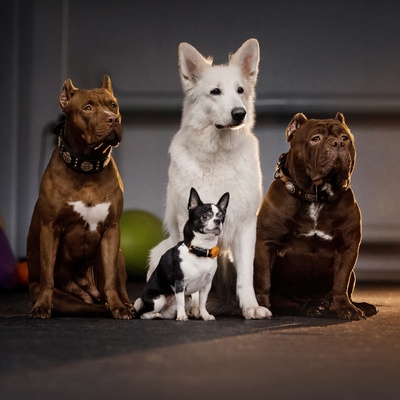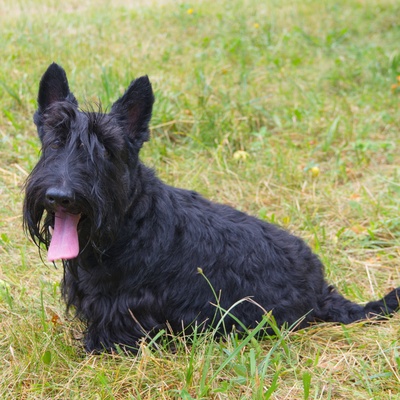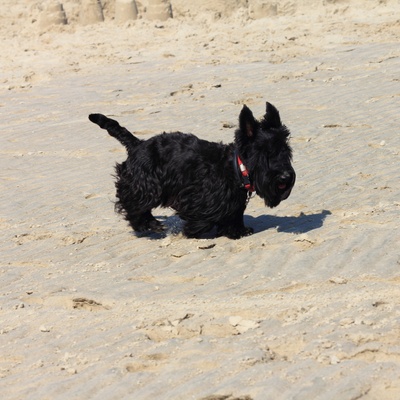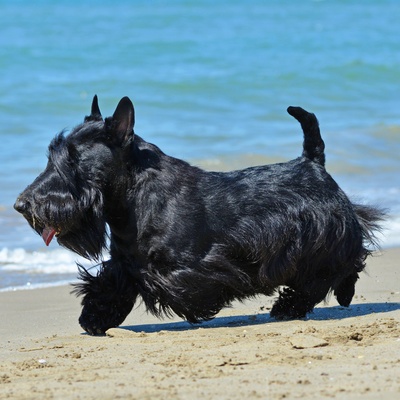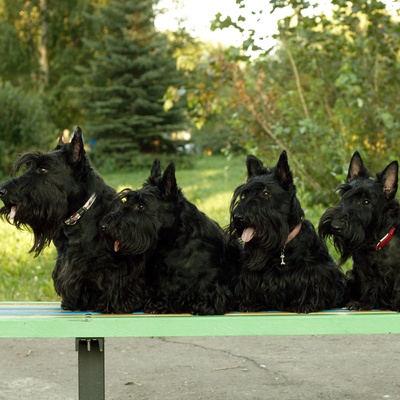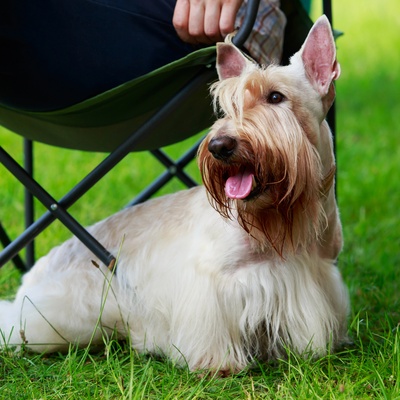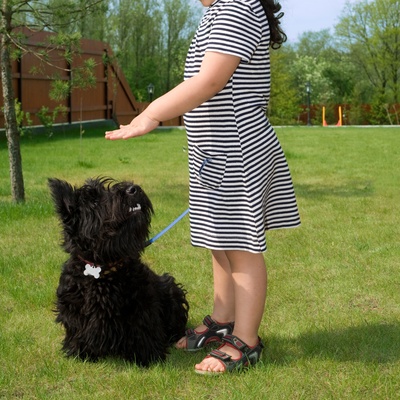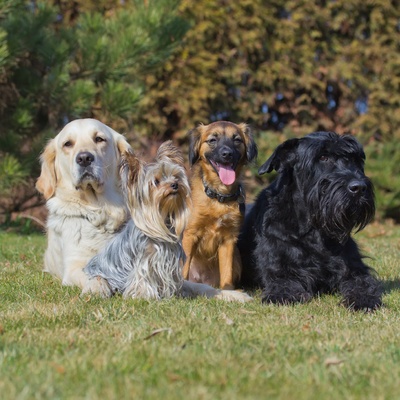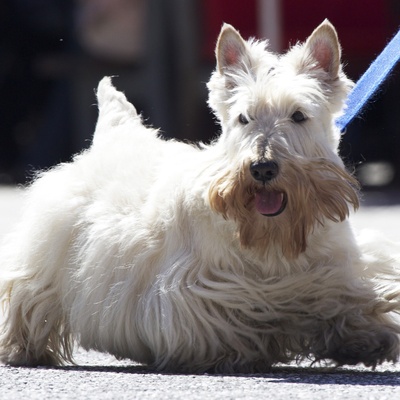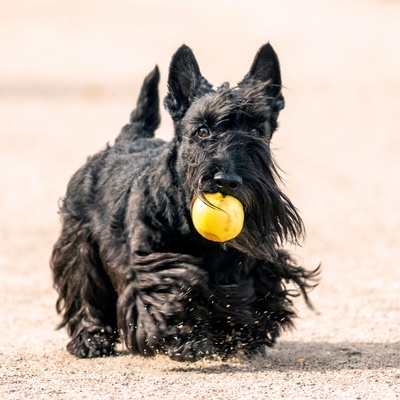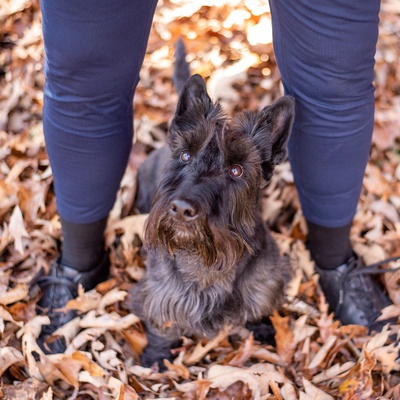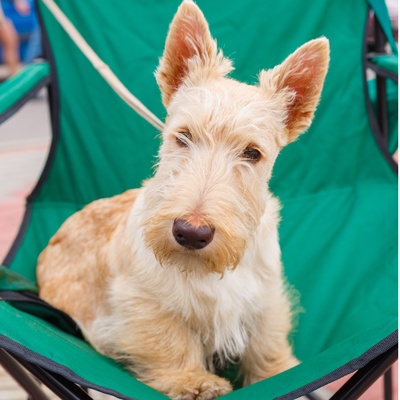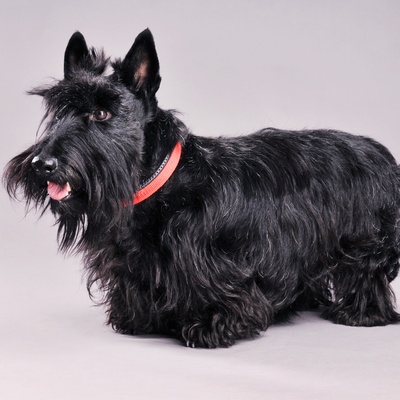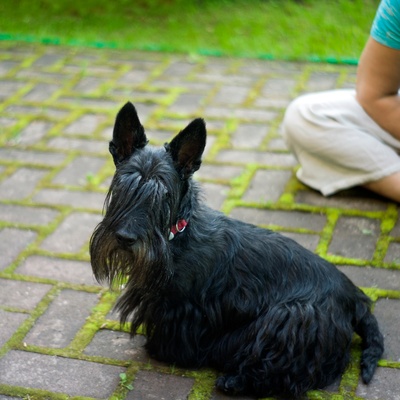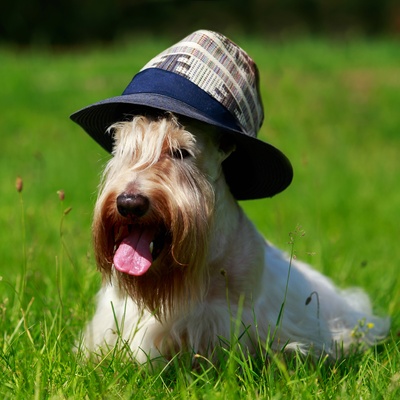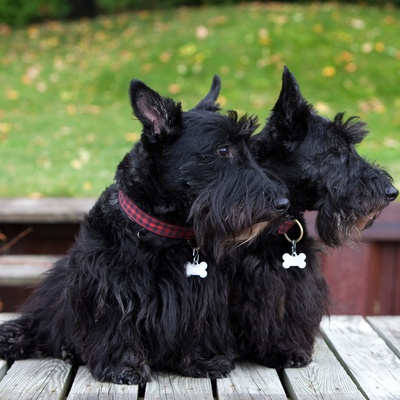Introducing the Scottish Terrier
Discover all there is to know about the Scottish Terrier: its characteristics, behavior, training, and its cost.

Discover all there is to know about the Scottish Terrier: its characteristics, behavior, training, and its cost.
The Scottish Terrier, or "Scottie", is a breed with deep roots in Scotland, celebrated for its bold demeanor and unique appearance. Despite its enigmatic origins, it stands as a symbol of bravery. These small yet fearless dogs are versatile, excelling as both watchdogs and loving family members.
They are known for their strong personality and loyalty, forming deep bonds with their owners and thriving on companionship. The Scottie's adaptability and spirited nature have made it a beloved breed worldwide.
This section outlines the unique features of the Scottish Terrier breed.
Belonging to the Terrier group (3), Scottish Terriers are spirited and brave, originally bred for vermin hunting.
Standing about 10 inches tall and weighing 18 to 22 pounds, they are small, sturdy, and muscular.
They feature a double coat with a wiry outer layer and a soft undercoat, suitable for all weathers.
Their coats are primarily black but can also be wheaten or brindle, each adding to their rugged charm.
Scottish Terriers are adaptable, fitting well in both apartments and homes with gardens, but require regular exercise.
Loyal to families yet independent, they are friendly with known children but vary in reaction to other animals. Socialization is important.
Generally healthy, they're susceptible to certain genetic conditions; regular veterinary check-ups are recommended.
With a strong-willed nature, they thrive on consistent, positive training, showing good learning capability when engaged.
We can help!
Every dog has its own character, and so do you. Making the right choice will ensure his well-being and yours.
Take our quiz to find out which breed is right for you, based on your personality, lifestyle, location and many other criteria.
Don't wait any longer and take the quiz to find out the answer!
Scottish Terriers are small, compact, and ruggedly handsome dogs. With a dense, wiry coat typically in black, and their bold, expressive faces featuring a distinctive beard and eyebrows, they encapsulate a unique blend of charm and tenacity.
Scottish Terriers present a compact frame, with females and males typically standing about 10 inches at the shoulder. Weight-wise, females and males usually range from 18 to 22 pounds, embodying strength in a small package.
Scottish Terriers mature at a moderate pace, reaching their full size and weight by the age of 12 months, marking their transition from spirited puppies to dignified adults with their characteristic sturdy and confident stance.
The Scottish Terrier is distinguished by its double coat: a hard, wiry outer coat and a soft, dense undercoat. This dual-layer provides excellent protection against harsh weather, with the outer layer repelling water and debris. The coat is longer on the beard, eyebrows, legs, and lower body, creating the breed's signature rugged appearance.
Scottish Terriers are primarily known for their classic black coats, but they can also sport wheaten or brindle hues. These colors contribute to the Scottie's distinctive look, with each shade offering its own unique appeal to enthusiasts of the breed.
The coat of the Scottish Terrier requires regular maintenance to keep it in top condition. Despite the tough exterior, the Scottie does not shed excessively but does require periodic hand-stripping or clipping to maintain the coat's texture and appearance. Regular brushing, at least weekly, is necessary to prevent matting, especially in the softer undercoat.
While they don't need frequent baths, a Scottish Terrier should be bathed every few months or as needed, always using dog-specific shampoo to protect their skin. Grooming is not only essential for their appearance but also for their overall health, helping to prevent skin issues and ensure comfort.
The Scottish Terrier presents a unique, balanced, and well-proportioned figure, instantly recognizable by its distinctive outline. The head is notable for its long, distinctive shape, contributing to their keen, alert expression. This breed features piercing, almond-shaped dark eyes that exude intelligence and a certain degree of stubbornness.
The ears are small, pointed, and erect, set well up on the head, enhancing their alert and lively demeanor. The body of the Scottish Terrier is compact and muscular, showcasing a sturdy and robust build despite its small size. This combination of features gives the Scottish Terrier its characteristic confident and dignified appearance, ready to face any challenge with spirited determination.
The Scottish Terrier is known for its bold, confident, and dignified temperament, displaying loyalty, protection, and affection towards its family. These dogs are independent yet loving companions.
The Scottish Terrier, a member of the Terrier Group (3), is known for its lively personality and distinctive traits, including a heritage of vermin hunting and home guarding. These dogs are energetic, fearless, and determined, with breeds like Bull Terrier, or Jack Russell Terrier sharing these qualities. The Scottish Terrier distinguishes itself with its strong-willed nature, excellent hunting instinct, and intelligence, making it both a rewarding and challenging breed to train.
While they may show a bold front, they are deeply affectionate with their families, showing a softer side to those close to them. Originally bred as hunters, Scottish Terriers have adapted to become cherished family companions, valued for their loyalty and enduring charm.
Scottish Terriers, with their distinctive appearance and bold personality, exhibit a fascinating blend of independence and deep affection towards their owners. These dogs are known for their strong-willed nature, often displaying a significant amount of self-reliance in their daily activities.
However, this independence does not detract from their capacity for affection. The presence of an attentive and understanding owner is crucial for the Scottish Terrier, as it helps in nurturing their confident yet affectionate temperament. While they may not demand constant attention, they thrive in an environment where interaction and companionship are readily available.
Scottish Terriers, while reserved at first, become sociable and friendly once familiar with someone. Their initial caution around new people is a natural terrier trait, but with comfort, they reveal a deep capacity for friendship and loyalty.
Proper socialization from a young age is crucial, helping them get along well with humans and be playful companions to children, albeit with supervision for the very young. Early socialization ensures they develop into well-adjusted, confident dogs, ready to engage positively in diverse social environments.
Take the test and find out the dog breed that matches your personality and lifestyle.
Scottish Terriers are remarkably adaptable, capable of thriving in various living situations, whether it be a cozy apartment or a spacious house, in bustling urban areas or serene rural settings. The key to their happiness and well-being, however, lies in the level of attention and engagement they receive from their owners. These terriers form strong bonds with their families and crave interaction and companionship.
As for physical activity, Scottish Terriers require regular walks to maintain their health and happiness. A daily routine consisting of at least two walks, each lasting around 30 minutes, is recommended to satisfy their need for exercise and exploration.
Despite their ability to adapt to indoor living, Scottish Terriers benefit greatly from having access to an outdoor space where they can indulge their curiosity and expend energy. Their terrier nature means they possess an innate desire to explore and engage with their environment, making a garden or yard an ideal setting for them to satisfy these instincts.
Such spaces not only allow Scottish Terriers to stay physically active but also provide mental stimulation, which is crucial for this intelligent and sometimes independent breed. Providing opportunities for outdoor play and exploration helps ensure that Scottish Terriers remain content, healthy, and well-balanced.
Scottish Terriers are known for their sharp intelligence and independent nature, which can make them both fascinating and challenging to train. They learn commands and tricks with ease, thanks to their superior intellect, but their independent streak means that training must be approached with patience and consistency.
The specific nuances of training a Scottish Terrier include the necessity of establishing clear leadership and making training sessions engaging and rewarding to keep their interest piqued. To mitigate their natural instinct to roam and explore, which can sometimes lead to escapes, equipping a Scottish Terrier with a GPS collar is a wise precaution. This ensures that, should they wander off, they can be easily located and brought back to safety.
Scottish Terriers show good listening skills with the right motivation, thriving on positive reinforcement like treats and praise for effective training. Their terrier heritage, however, introduces a stubbornness, particularly with commands they deem arbitrary or when not inclined to follow. This highlights the need for patience and creativity in their training.
Adapting training methods to leverage their intelligence and unique traits can cultivate a well-mannered Scottish Terrier. Harnessing their determination and energy can lead to impressive training achievements, making them adaptable and capable of mastering various behaviors and commands.
Scottish Terriers are generally healthy dogs, but like all breeds, they require daily care and attention to prevent diseases and maintain their well-being. Regular grooming, exercise, and veterinary check-ups are essential components of their care routine to keep them in top health.
Scottish Terriers are known for their robust health, but they do have certain breed-specific predispositions that owners should be aware of. Common health issues include Scottie Cramp, a condition that affects their ability to move, and Von Willebrand's Disease, a blood disorder. They may also be prone to certain cancers and bladder stones.
Symptoms vary depending on the condition but can include difficulty walking, excessive bleeding after injury, or signs of discomfort when urinating. The typical lifespan for a Scottish Terrier ranges from 12 to 15 years, indicating their overall resilience and longevity with proper care.
Regular veterinary care is crucial for a Scottish Terrier's health. This includes vaccinations, deworming, and treatments for fleas and ticks as recommended by a veterinarian. Daily care practices are equally important; brushing their dense coat several times a week helps prevent matting and skin issues, while regular ear cleaning and dental care are vital to avoid infections and dental diseases.
It's also important to monitor for signs of allergies and consult a vet for guidance on management.
Scottish Terriers thrive on a diet that is carefully balanced with the right mix of proteins, vitamins, and essential nutrients. Opting for high-quality kibble specifically designed for their dietary needs ensures they receive a well-rounded blend of essential fatty acids, minerals, and antioxidants crucial for their health.
For those Scottish Terriers with higher energy levels, supplementing their diet with lean proteins such as chicken, turkey can provide an extra boost, though it's vital to keep an eye on the fat content to avoid the risk of obesity. Implementing a consistent feeding schedule and monitoring portion sizes are key strategies to prevent overfeeding, ensuring these energetic dogs stay fit and healthy.
Scottish Terriers are valued for their distinct personality and appearance, with many breeders offering options for potential owners. Before adopting, it's crucial to weigh several factors to ensure they match your lifestyle and environment.
Before adopting a Scottish Terrier, it's crucial to make an informed decision. Ensuring the breeder is reputable is paramount. Visiting the breeder's premises allows you to observe the living conditions and behavior of the dogs, providing insight into their upbringing. The health of the puppy and its parents is also a key consideration; reputable breeders will be transparent about any health issues or genetic predispositions.
Lastly, mandatory electronic identification, like microchipping, is not always mandated at the federal level in the United States for cats and dogs. But microchipping is widely acknowledged as a successful way to permanently identify pets and increase the possibility of reuniting lost pets with their owners, even in the absence of universal regulations. As a pet owner, it is advised to inform yourself about municipal laws to ensure the safety and wellbeing of your pet.
The cost of acquiring a Scottish Terrier puppy can vary significantly based on factors such as lineage, pedigree, the breeder's reputation, or the dog's age. Generally, the price range for a Scottish Terrier puppy can be anywhere from
to
.
However, it's important to remember that the initial cost is just part of the overall responsibility. Annual expenses for maintaining a Scottish Terrier, including food, veterinary care, grooming, and insurance, can add up to an estimated
to
. These figures serve as a guide to help potential owners budget for the lifetime care of their new companion.
Choosing a dog that matches your personality and lifestyle will ensure your well-being and his!

